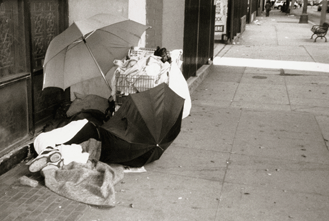Women in Downtown Los Angeles Speak Out
Film documentary
Directed by
Corina Gamma
Produced by
Corina Gamma & Gizi Weibel
© 2005
Synopsis
 Over the course of one year, approximately 250,000 people are homeless in the Los Angeles County. An estimated 80’000 people in Los Angeles County are homeless at any given night, between 35% – 45 % are women. Only six city blocks from the financial district of downtown Los Angeles is ‘Skid Row’, an area with a large concentration of missions and shelters, which makes it the largest emergency-service dependent community in the United States. These services keep the homeless in a very isolated area.
Over the course of one year, approximately 250,000 people are homeless in the Los Angeles County. An estimated 80’000 people in Los Angeles County are homeless at any given night, between 35% – 45 % are women. Only six city blocks from the financial district of downtown Los Angeles is ‘Skid Row’, an area with a large concentration of missions and shelters, which makes it the largest emergency-service dependent community in the United States. These services keep the homeless in a very isolated area.
The documentary Ties on a Fence: Women in Downtown Los Angeles Speak Out is a compendium of conversations and interviews with women who are currently residing in the downtown Los Angeles Skid Row. The women who participated in this film are either homeless, at the periphery of it, or in a transitional situation. They tell their stories, struggle and their experiences of poverty as they are trying to navigate through the various bureaucracies of government programs. Many of them are trying to overcome personal dilemmas, either resolving past experiences or escaping them altogether. Some of the documented conversations reveal that “homelessness” is more than just a physical situation, but it is also a condition of poverty and becomes a state of mind.

FESTIVALS
The “Other Venice Film Festival”, Venice, CA (2006)
Docufest, Atlanta Underground FIlm Festival, 2006
Women’s Conference, Scripps College, Claremont, California (2005)
Human Rights Film Festival, Echo Park Film Center, Los Angeles, California (2005)
Santa Clarita Film Festival, Santa Clarita, California (2005) [Award for Best Documentary]
“Not a Cornfield”, Los Angeles, California(2005)
Swiss-American Film Festival, New York (2004)
Detroit Docs Film Festival, Detroit, Michigan (2004)
Black Earth Film Festival, Galesburg, Illinois (2004) [Award for Best Documentary]
Berkeley Film Festival, Berkeley California (2004)
AWARDS
Best Documentary: Black Earth Film Festival, Galesburg, Illinois, 2004
Best Documentary: Santa Clarita Film Festival, Santa Clarita, California 2005
REVIEWS
“This is a documentary that cares about the subject manner. Homelessness in America is at epidemic proportions. This doc takes a look at one very specific area: How women deal with homelessness in Downtown Los Angeles. The insanities of Skid Row are examined from the participants who actually live and survive it everyday. The filmmakers do a great job of bringing these stories to life”. – Dan Green (Juror), Black Earth Film Festival, Galesburg, Illinois.
Comment after a screening:
David Buss, seems quite young and healthy and wonderfully in charge of the world. David was homeless and on skid row for many years. He came to a screening with his charming wife – they have children. He commented, that we have lost our social conscience and we do not care for each other like we should. Another lady said she was the victim of abuse and claims 1 in 4 women are so. She attributes this to a hierarchical society. Another lady fled Germany as a child with her family. They were homeless and stayed in a refugee camp. They had a community kitchen, bathrooms, schools, and other things. She did not mention it, but they clearly had dignity. According to her, they were much better off than those people in the film about Los Angeles Skid Row. Some people were fairly shocked by the movie and said you never see anything like this in the mainstream media. Several people in the audience had been involved in Habitat projects. They were working on house projects, and spoke of a an other lady who was going to live in one of the houses. She had a child and this was the first home she ever lived in. They were going to give her training in how to live in a home and how to pay her bills.
Special Thanks to:
The Downtown Women’s Center (DWC)
who helped facilitate this Documentary
and Lisa Watson, former Executive Director [DWC]
